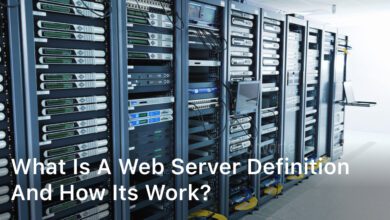In an era where data is king, businesses constantly search for better server function. Peak server performance depends on strong hardware and smart optimization methods.
Companies keen on improving their digital setup see server optimization as key to success.
A closer look at server optimization shows many strategies.
Each one aims to enhance efficiency, speed and reliability if done right.
Understanding the Basics of Server Performance
When we talk about server performance, two main elements stand out: server efficiency and speed.
These elements are crucial for strong server management. They impact how an organization’s IT setup works.
Defining Server Efficiency and Speed
Server efficiency looks at how servers use their CPU, memory and storage well.
Server speed shows how quick a server can handle requests. Speed is very important in our fast digital world.
Key Components Affecting Server Performance
Many factors affect server performance, from visible stuff like hardware to behind-the-scenes things like software and networks.
Each aspect is key to how a server works, especially under heavy use.
- Hardware Specifications: Including processors, RAM and storage systems.
- Network Connectivity: Bandwidth and network infrastructure’s quality.
- Software Configurations: Operating systems, applications and management tools.
- Workload Distribution: Allocation and scheduling of tasks across server resources.
Metrics to Measure Server Performance
To check on server performance, watching certain metrics is vital. These metrics help IT pros find what needs work. They can then make improvements based on data.
| Metric | Description | Relevance to Performance |
|---|---|---|
| Response Time | The duration between a request and the server’s response. | Directly impacts user experience and satisfaction. |
| Throughput | The number of tasks processed in a given time frame. | Indicates the server’s ability to handle workload. |
| Concurrency | The simultaneous handling of multiple operations. | Measures server’s multitasking capabilities. |
| Error Rates | The frequency of failed requests or operations. | Essential for assessing the reliability of server operations. |
Using these metrics for server checks helps keep servers efficient and fast.
This way, we can dodge server slowdowns and other issues.
Strategies to Enhance Server Speed

To boost server speed you can use this steps and also elevate server efficiency and performance.
These aren’t just theories, they are actionable steps.
These steps can noticeably improve server operations. This highlights how vital server speed is for a business’s tech setup.
- Load Balancing: Distributing network traffic across multiple servers can prevent any single server from becoming a bottleneck, enhancing response times and overall server speed.
- Caching: Implementing caching strategies, such as storing frequently accessed information in memory, dramatically reduces access times to critical data and improves server efficiency.
- Content Delivery Networks (CDNs): Utilizing CDNs to serve multimedia content from locations closer to the end-user helps to cut down latency and speed up content delivery.
- Optimizing Database Queries: Refining database queries to be more efficient can reduce server load and speed up data retrieval, yielding a more streamlined experience.
It’s important to take a closer look at each strategy’s role. A detailed table below shows how each contributes.
It helps us understand their impact on making a server work better and faster.
| Strategy | Description | Benefits |
|---|---|---|
| Load Balancing | Spreading workload across various servers to manage traffic efficiently. | Reduces server overload and ensures uptime, improving performance under high traffic conditions. |
| Caching | Temporary storage of data to fulfill future requests swiftly without reprocessing. | Decreases database load and enhances speed by serving repeat data requests quickly. |
| Content Delivery Networks | A distributed network of servers delivering web content based on user location. | Improves global access speeds and reduces latency, particularly for media-heavy content. |
| Database Query Optimization | Improving the efficiency of database interactions through refined SQL queries. | Minimizes execution time for data retrieval, enhancing overall server response. |
Putting these strategies to work can boost server speed and its overall ability.
Your server setup becomes scalable, efficient and more reliable.
This ensures it meets business goals and user needs better.
Tips and Tricks Optimize Server Performance
Scaling server performance is key in today’s digital world. It’s about finding a balance. You need great hardware, smart software and regular care.
This makes a server perform at its best. Let’s dive into tips to make your server work better.
Hardware Upgrades for Improved Efficiency
Boosting server performance starts with the latest hardware. Add powerful processors, more memory and fast SSD storage.
Your server will respond quicker and handle big tasks easily. These aren’t just upgrades, they totally change how efficient your server is.
- Processor: Trading up for a higher-end CPU to better manage demanding tasks.
- Memory: Increasing RAM capacity to bolster multitasking capabilities.
- Storage: Switching to SSDs or augmenting storage with faster solutions for swift data access and transfer speeds.
Software Tweaks to Maximize Performance
Software changes might seem small, but they add up to a big difference. Tweak server settings and use compression to make data move faster. These steps make your server run smoother.
- Configuration: Adjusting software settings to better align with server workloads.
- Optimization: Streamlining software operations to reduce resource consumption.
- Compression: Utilizing data compression tools to enhance transmission speed and storage efficiency.
Regular Maintenance Schedules
Consistent maintenance is vital for keeping a server at its best. Update regularly and check logs to stop problems before they start. Keeping your server clean also keeps it running fast.
- Software Updates: Keeping server software and applications up to date to defend against vulnerabilities and enhance functionality.
- Log Monitoring: Regularly checking system logs to preemptively identify and rectify issues.
- Cleanup Routines: Routinely removing obsolete files and data to free resources and improve server agility.
Server Performance Tuning: Advanced Techniques
We’re looking into top strategies for server performance tuning.
These methods are key for making modern servers work better.
They help servers share content faster, handle network traffic better, and get data quickly with less load.
Database Optimization Methods
For better server performance, database optimization is crucial.
Indexing is important because it makes searching and getting records faster.
This cuts down the time for queries.
Also, improving database layouts and using smart query methods reduces operations and CPU use.
Network Settings for Peak Performance
Adjusting network settings can greatly improve a server’s work.
Careful control of bandwidth and using Quality of Service (QoS) rules help a lot.
This makes data transfer efficient. Also, handling network traffic well makes sure data moves smoothly.
Utilizing Caching for Faster Data Retrieval
Caching is key for quick data access. It saves time by keeping often-needed data ready.
Using caching at the server level, like using memory or disk-based methods, plus caching on the client side, cuts down on extra server requests.
| Optimization Technique | Purpose | Impact on Performance |
|---|---|---|
| Database Indexing | Accelerate search and retrieval operations | Reduces query processing time, boosts throughput |
| Bandwidth Allocation | Manage data transfer between server and clients | Optimizes data flow, minimizes latency |
| Quality of Service (QoS) | Define priority of different data types | Ensures critical server requests are prioritized |
| Server/Client-side Caching | Store commonly accessed data | Reduces load on servers, accelerates content delivery |
Peak Server Performance
Leaders in tech are always searching for tools to boost server performance.
They use a mix of hardware and software for top results.
Getting there is tough but possible, and vital for success in the tech world.
Conclusion
To reach top server performance, businesses need to carefully explore and improve their systems.
It’s clear that making servers faster and more efficient requires careful planning and ongoing work.
To boost server performance, a holistic approach is key.
This approach looks at server designs and uses cutting-edge methods to enhance operations.
This article highlights the importance of fine-tuning both hardware and software to improve server performance. By using strategies like load balancing, content delivery networks, regular upkeep and AI-driven analytics, companies can build a strong server management system.
This careful adjustment creates a system that’s strong, quick to respond, and ready for heavy data use.
The goal of improving servers is critical, not just a techie challenge but an investment in a business’s core data center.
As companies compete in the digital world, improving servers is essential.
It leads to more productivity, happier users, and a stronger position in the market.
Achieving top server performance sets successful, forward-looking businesses apart.
FAQ
What is server efficiency and speed?
Server efficiency means using resources well for top performance. Server speed is how fast a server responds to requests.
What are the key components affecting server performance?
Server performance depends on hardware, network, software, and how tasks are shared.
What are the metrics to measure server performance?
Key metrics for server performance include response time and throughput. Also, how many tasks it can handle at once, and error rates.
What are some strategies to enhance server speed?
To speed up servers, you can use load balancing and caching. Also, content delivery networks and database query optimization help.
How can I optimize server performance?
Boosting server performance can include hardware upgrades and software adjustments. Also, setting a regular maintenance schedule.
What are the best practices for server configuration?
For the best server performance, optimize server software and manage resources well. Also, ensure to set up strong security.
What are some advanced techniques for server performance tuning?
Advanced tuning includes optimizing databases and network for better performance. Also, use caching for quicker data access.
How can I achieve peak server performance?
Peak performance requires discovering the best tools and using AI for optimization. Also, compare your performance with industry standards.
Why is server optimization important?
Optimization improves server speed and efficiency. This leads to better server productivity, enhanced user experience, and a competitive advantage.





